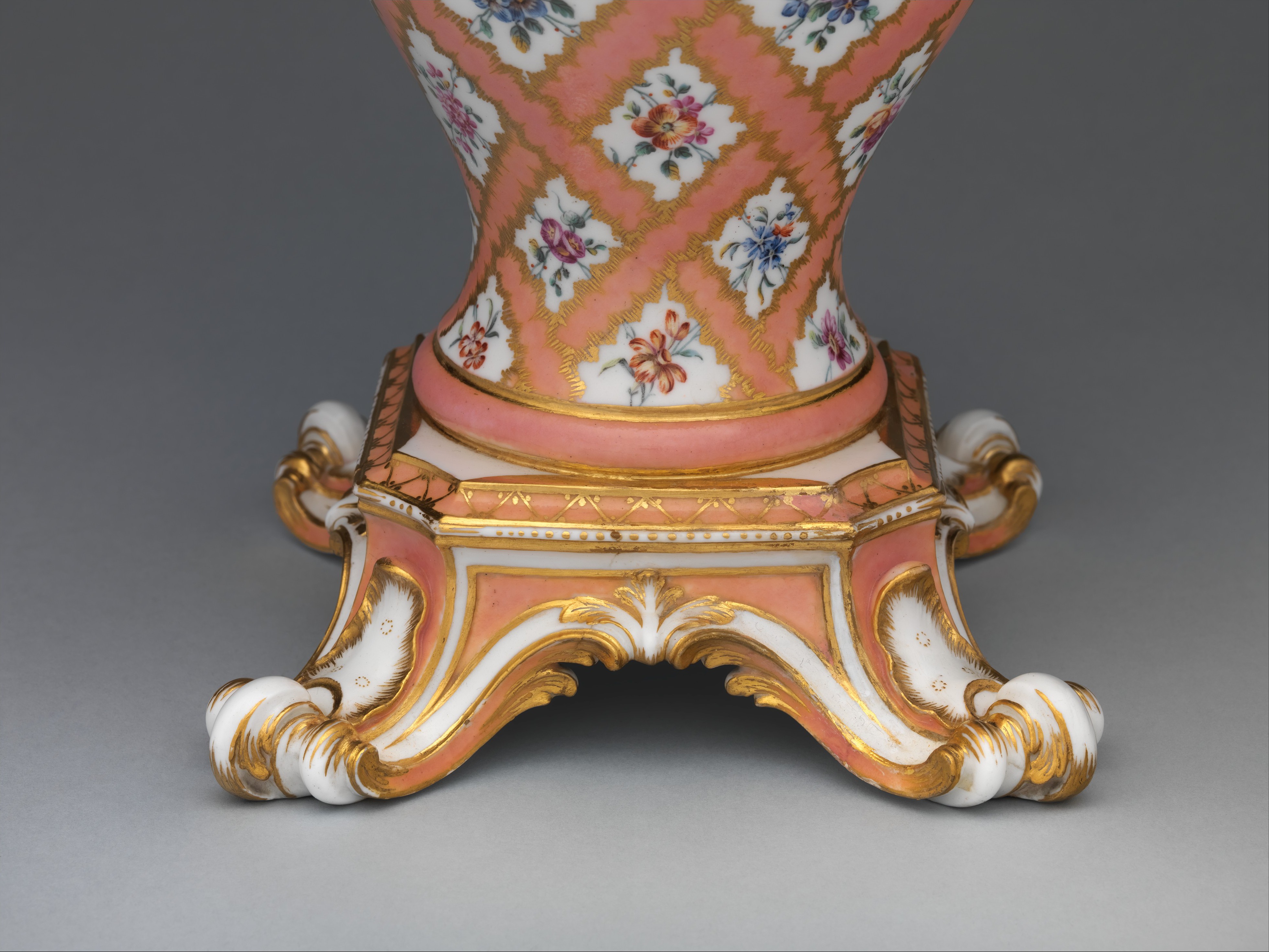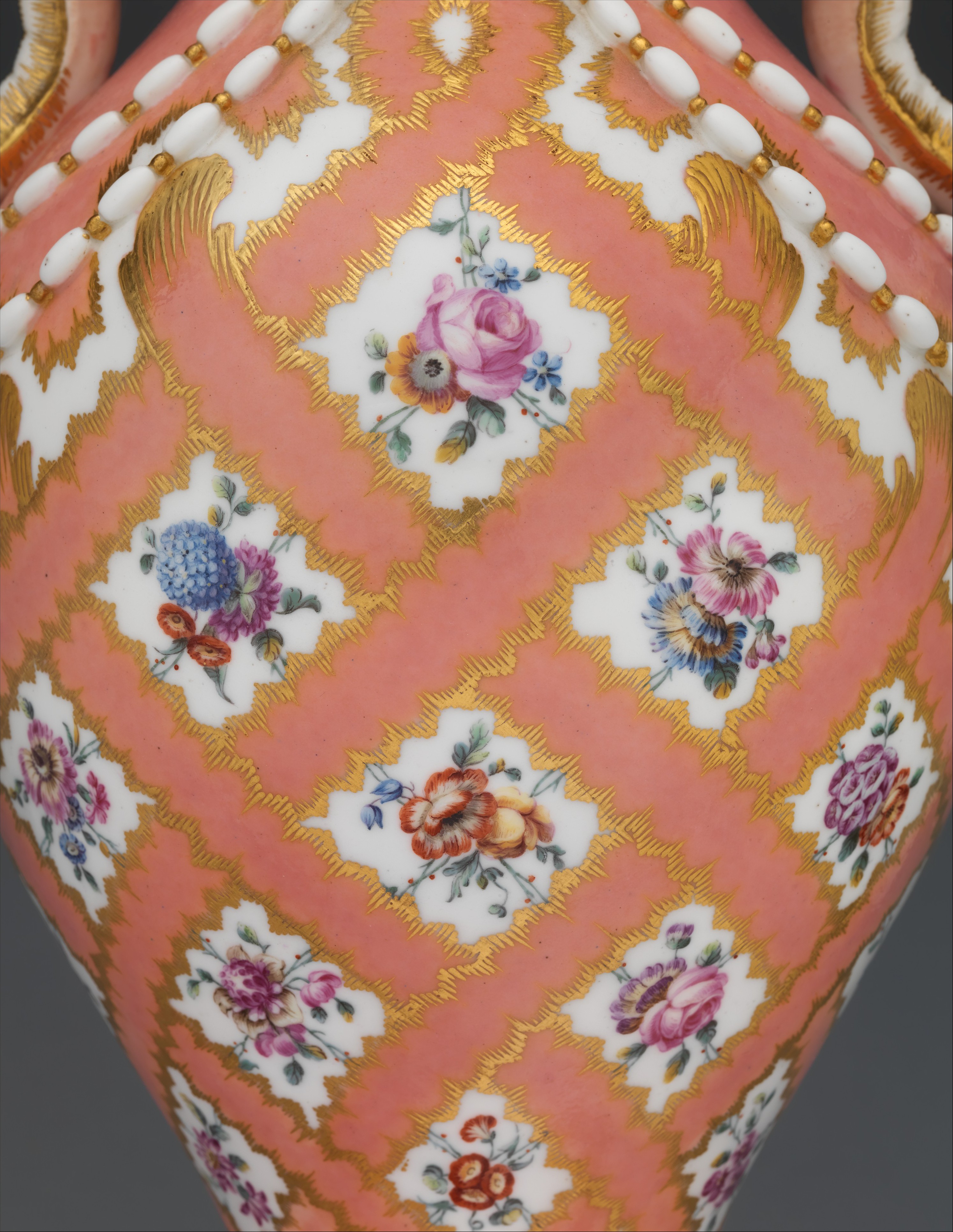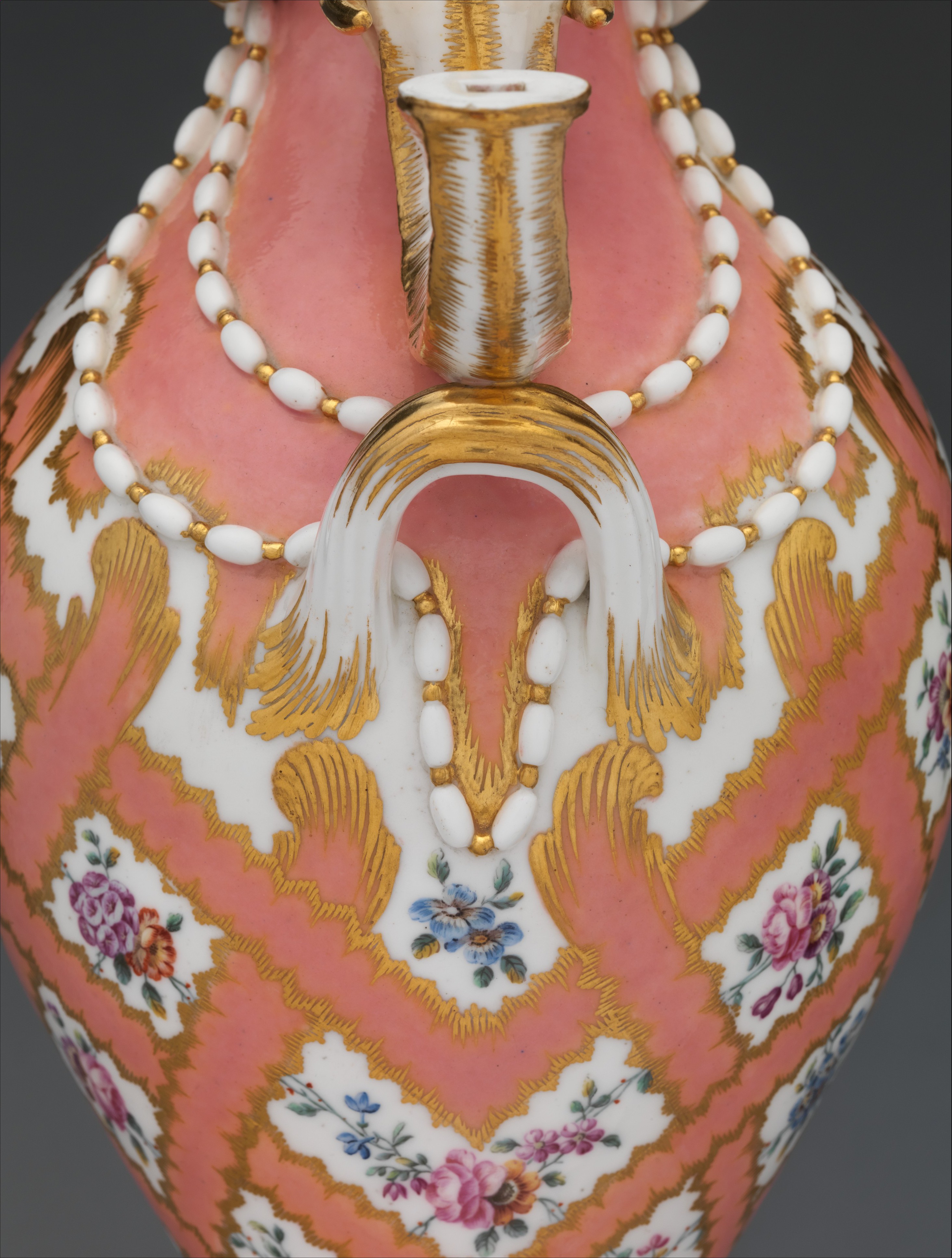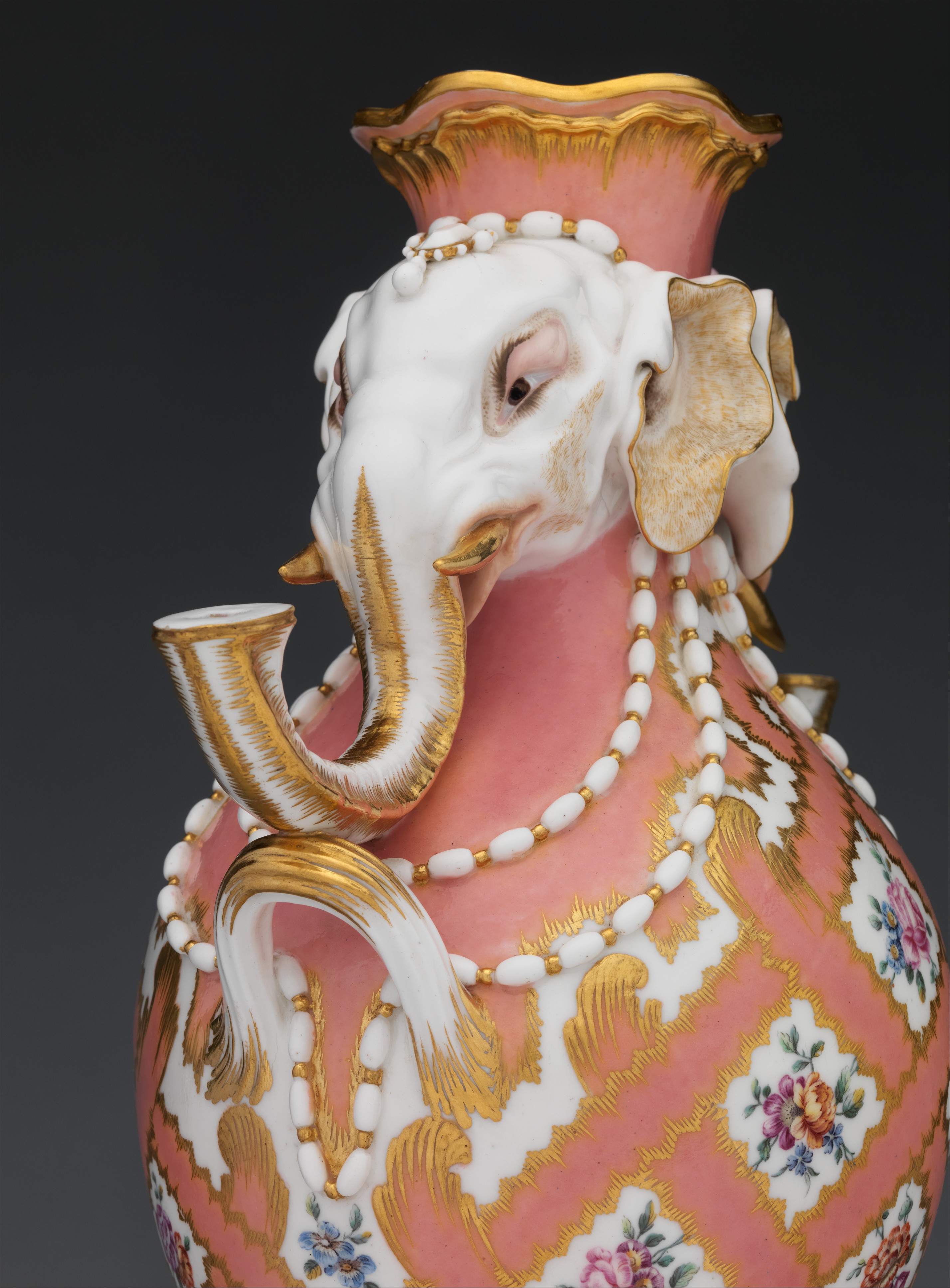Vase (vase à tête d'éléphant) (one of a pair)
Modeler Jean-Claude Duplessis French
Manufactory Sèvres Manufactory French
These three vases (58.75.89a, b–.91) were originally accompanied by two additional vases to form a set, or garniture, that was one of the most extraordinary and expensive garnitures produced at Sèvres during the eighteenth century. The boat-shaped vase, known at the factory as a pot-pourri à vaisseau or a pot-pourri en navire, would have occupied the central position in the grouping flanked by the two elephant-head vases (vase à tête d’éléphant) and two vases with ear-shaped handles (vase à oreilles) now at the Musée du Louvre, Paris.[1] The garniture is remarkable not only for its originality of the vase forms but also for its novel and extremely highquality decoration.
The body of the center vase is in the shape of a boat with marine masks at both ends and truncated bowsprits emerging from the mouths of the masks. The lid, which is formed from shrouds or rigging that alternate with pierced panels to represent sails, is a separate upper section of the vase that includes a pennant descending from the masthead.[2] The form of this remarkable potpourri vase evolved from two earlier vase shapes made at Sèvres,[3] but the concept—a vase in the form of a boat with sails—was entirely new. The design for the pot-pourri à vaisseau is attributed to Jean-Claude Duplessis (Italian, ca. 1695–1774), the creative head of the sculpture workshop at Sèvres who was responsible for many of the factory’s most innovative designs. This model of potpourri vase was first produced in 1758, and the Museum’s example is one of the first created.[4] The lid in the form of sail rigging must be one of the most technically challenging designs made at Sèvres, based on the extensive and intricate perforations incised in the clay while only partially dry. If successfully executed in this so-called leather-hard state, the lid could have been damaged, or it could have collapsed during the firing due to fragility in the unfired state.
It appears that very few of these potpourri vases were made, probably because of the technical difficulties in fabricating them, and hence, the costs involved. Only four of this model can be identified in the factory’s sales records, and ten are known to have survived today.[5] In addition, factory records indicate that these boat-shaped vases were only produced for a seven-year period, since after 1764 their very Rococo design would no longer have been fashionable.
The elephant-head vase, introduced at Sèvres two years before the boat-shaped vase, was equally innovative in form. Duplessis is known to have supplied the design for the vase,[6] which was intended to support candles in addition to being decorative.[7] Elephant-head vases were made in three sizes, of which this pair represents the largest, and the vase design was modified in minor ways during the relatively short period that it was in production (1756–62). The handles that appear under the elephants’ trunks reflect one modification, added presumably to provide extra support for the trunks.[8] The source of inspiration for Duplessis’s design, and for the prominent elephant heads in particular, has been much debated, including discussions of Chinese, Japanese, and Meissen porcelains as possible models.[9] A plausible model may lie in either the Japanese so-called birdcage vases that were avidly collected by August II (1670–1733), commonly known as Augustus the Strong, elector of Saxony, king of Poland,[10] or in the Meissen copies of the Japanese originals,[11] but these vases are only distantly related to Duplessis’s design, which is one of the most unexpected of all those produced at Sèvres. While the elephant-head vases were made in larger quantities than the boat-shaped vases, their high cost, which ranged from 360 to 960 livres,[12] necessarily limited the scope of production.[13]
The boat-shaped vase, the two elephant-head vases, and the two vases now at the Louvre were among the porcelains included in the sale held in King Louis XV’s (1710–1774) private apartments at Versailles in late December 1758. Sales of the latest production from Sèvres, which took place annually at Versailles in late December and early January, had been initiated by Louis XV to encourage the factory’s sales, and the event proved lucrative for the royal manufactory.
Among the highest-priced purchases made that year was by Louis-Joseph de Bourbon (1736–1818), prince de Condé, for the five vases. The factory’s sales records show that he paid 1,200 livres for the boat-shaped vase, 1,680 livres for the two elephant-head vases, and 1,440 for the two vases now in the Louvre.[14] This total of 4,320 livres was an enormous sum, exceeding the annual salary of a typical professional worker in France at this time.[15] Louis-Joseph may have been drawn to the extraordinary shapes of the five vases, or to the striking pink ground color newly developed at the factory, which was described at the time as "very fresh and greatly pleasing."[16] It seems that the first porcelains decorated with this new ground were introduced at the same sale at Versailles in December 1758,[17] and the visual impact of this startling color must have been considerable. The boat-shaped vases and the two Louvre vases are decorated with reserves of putti with various attributes, while the two elephant-head vases are painted solely with interlaced pink ribbons together with small bouquets of flowers in the interstices. Because it was common factory practice for the decoration to be coordinated among the components of a garniture, the absence of reserves with putti on the elephant-head vases is slightly surprising. It is possible that the elephant-head vases were not produced to accompany the other three vases, and the five vases, united by their pink ground color, were assembled by Louis-Joseph to create a garniture.
It is likely that Louis-Joseph purchased the vases for his wife, Charlotte Godefride Élisabeth de Rohan (1737–1760), since they are listed among the contents of her bedroom in an inventory taken after her death.[18] An inventory from 1779 indicates that four of the five vases were at that time in the possession of Louise-Marie- Thérèse- Bathilde d’Orléans (1750–1822), duchesse de Bourbon, and the daughter-in- law of Louis-Joseph. The pair of elephant-head vases and the pair of vases now in the Louvre were placed on a commode in her bedroom in the Palais Bourbon;[19] the boat-shaped vase was not listed with them, presumably having been placed elsewhere in the residence. At the time of the French Revolution (1789–99), many of the Bourbon possessions seized by the government were sold, but the five vases were among the finest objects retained by the Commission temporaire des Arts.[20] Eventually given to a "citoyenne Denor," the vases were sold at auction in 1797.[21] They were separated at some point during the first half of the nineteenth century, because the pair of vases with ear-shaped handles appeared alone at auction in London in 1855.[22]
The three vases at the Museum are among the most extravagant creations of the factory, reflecting its willingness to expand the boundaries of taste through bold and innovative design. The popularity of the pink ground color, known as rose at the factory, waned after 1764, the year in which the last of the boat-shaped vases is recorded in the sales records and approximately two years after the elephant-head vases ceased to be produced. Both the forms of the two vase types and the pink ground color are manifestations of the full-blown Rococo style at Sèvres; by the mid-1760s, the emerging taste for Neoclassicism favored more restrained shapes and less-brilliant color.
Footnotes
(For key to shortened references see bibliography in Munger, European Porcelain in the Metropolitan Museum of Art. NY: The Metropolitan Museum of Art, 2018)
1. See Marie-Laure de Rochebrune in Musee du Louvre 2003, pp. 134–37, no. 78; Guillaume Seret in Durand, Bimbenet-Privat, and Dassas 2014, pp. 326–27, no. 125.
2. For a fuller description of another example of this model, see Bellaigue 2009, vol. 1, p. 122.
3. See ibid., p. 124.
4. For a fuller history of this model, see Savill 1988, vol. 1, pp. 191–97, no. c256; Sassoon 1991, pp. 49–55, no. 10.
5. Sassoon 1991, p. 50.
6. Savill 1988, vol. 1, p. 154.
7. Few retain their candle sockets due to the fragility of the porcelain.
8. Savill 1988, vol. 1, p. 154.
9. Brunet 1972, p. 3; Savill 1988, vol. 1, p. 154.
10. See Strober 2001, p. 207.
11. See Cassidy-Geiger 2008, pp. 204–8, no. 22.
12. Savill 1988, vol. 1, pp. 154–55. According to Rosalind Savill, an exception is the example with a price of 288 livres that was included in the list of old stock in 1773.
13. Twenty-two examples are known today, six of which are in the Museum; see ibid., pp. 161–62, n. 3.
14. Archives, Cite de la Ceramique, Sevres, Vy 2, fol. 78r, December 1758.
15. Sargentson 1996, p. xi.
16. Savill 1988, vol. 3, p. 1078.
17. Marie-Laure de Rochebrune in Salmon 2002, p. 444.
18. Rochebrune in Musee du Louvre 2003, pp. 135–36.
19. Rochebrune in ibid., p. 136.
20. Rochebrune in ibid., p. 137.
21. Baulez 1987, p. 53.
22. Ibid., p. 57, n. 55.
Due to rights restrictions, this image cannot be enlarged, viewed at full screen, or downloaded.
This artwork is meant to be viewed from right to left. Scroll left to view more.







